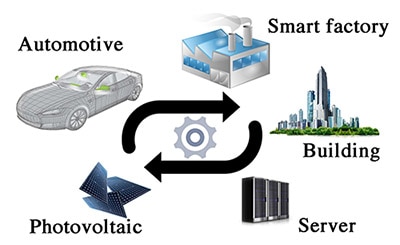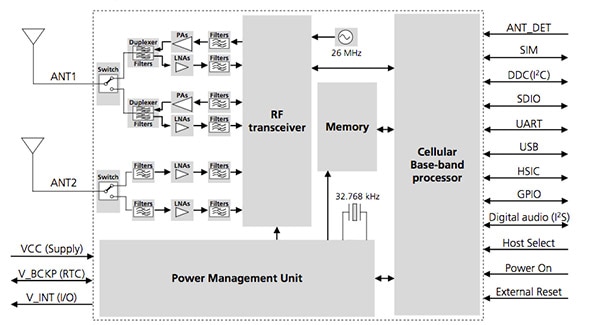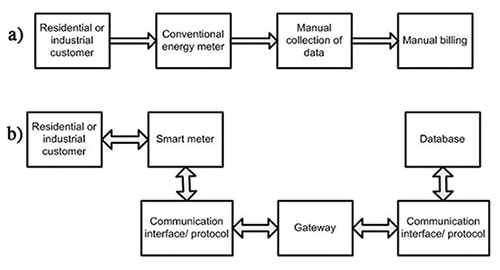Cellular Connectivity for Smart Metering
投稿人:DigiKey 欧洲编辑
2017-11-08
Wireless embedded modules have simplified the development of IoT hardware and software devices. The choice and the design are often driven by performance requirements such as operating range, data rate, security, and interoperability with other products. Cellular WAN solutions offer a number of advantages for smart metering applications, including lower communications infrastructure costs.
Smart metering and smart grid
The transformation of measurement instrumentation in recent years has vastly improved quality in control engineering, allowing far greater analysis and interpretation of data by virtue of an active interface to the various electronic systems. In particular, traditional mechanical and electromechanical energy meters, such as water and gas, can be replaced with digital metering capabilities. In a similar period, the internet-based device industry has also changed dramatically, and this change is omnipresent: just observe how people on the street use smartphones as an extension of our senses.
Energy providers around the world are investing in new technologies to optimize existing smart grids. Using a bidirectional and digital end-to-end intelligence infrastructure, utilities can capture details of how energy is transmitted and consumed in real time. ABI Research estimates that by 2020, the number of smart meters deployed globally will reach 780 million for electricity, 150 million for gas and 90 million for water. It's a huge market opportunity. Connectivity technology will be the key choice. The smart grid concept (Figure 1) includes an array of technologies such as energy production (renewable energy, distributed generation sources, etc.), transmission and distribution, intelligent measurement (residential, commercial and industrial), and electric vehicles (station management charging).

Figure 1: The smart grid is a power distribution network with intelligent sensors that collect real-time information.
Smart meters are helping to modernize the power grid, offering a remote monitoring capability with the means to transfer information about energy quality and power more frequently and reliably. By collecting energy consumption information in real-time, smart metering infrastructures allow vendors to reduce costs by better management of their operations. At the same time, smart metering improves forecasts and reduces energy consumption, simplifies micro-generation monitoring, and monitors the generated and consumed energy. Smart metering is definitely also a benefit for end customers, offering them energy savings and greater reliability of services.
To ensure that all these benefits are real, however, utilities need a secure and existing bi-directional communication infrastructure to connect and communicate with the various smart meters present in a given location. While power line communication (PLC) and various types of radio frequency (RF) technology have historically been used for large-scale measurement infrastructures, cellular communication is now the preferred choice. The mobile network is ideal because it is an existing and proven infrastructure, with almost complete coverage in most regions. Cellular technology enables the utilities to acquire meter readings remotely, more frequently, and with a much lower cost. In addition, cellular technology simplifies hardware and software deployment, and improves operational efficiency compared to other solutions. In many ways today's smart meters are plug-and-play, allowing faster, less complicated and cheaper installations. Mobile operators facilitate integration with back-end management, billing, and remote cloud management systems. These systems benefit from the software and platforms that already support millions of devices and use strong encryption, secure connectivity, and secure access mechanisms to keep the network and its customer data extremely safe. The implementation of various smart meters, such as those relating to water usage, comes at a time when concerns about the environment and discussions on sustainability and efficiency are highly topical. By developing cellular technology, for example, intelligent water meters and measurement infrastructures can now play a crucial role in water conservation.
The cellular network
Power providers have long been using WAN wireless solutions to communicate with meters in a large number of applications. Today, cellular technologies are becoming an important part of smart metering and smart grid implementations as a whole. Vendors have two primary WAN / cellular technology options: second generation (2G) and third generation (3G). Most of today's mobile point-to-point smart metering infrastructure is part of the global system for mobile communications (GSM) network, and uses the general packet radio service (GPRS) data service, a low cost 2G solution. However, newer 2G mobile smart measurement infrastructures are more likely to use the evolution of GPRS, enhanced data rates for GSM evolution (EDGE). EDGE technologies offer more bandwidth and faster connection speed than GPRS, and allow you to connect multiple devices to the network. Utilizing their bandwidth and transmission speeds, 3G, 4G, and later technologies are expected to play an important role in smart metering implementations.
For cost and capacity reasons, suppliers tend to work with 3G and 4G networks, making them more attractive and convenient for smart metering projects. As a result, power providers may have a wide bandwidth available in their metering applications, providing opportunities for additional consumer services. Another reason for intelligent 4G sensors is that the latest long-term evolution (LTE) version includes LTE-M, a new part of the specification designed for machine-to-machine communications. LTE-M standards like category 1, M1 and NB1 (also known as NB-IoT) are optimized for high numbers of devices, low levels of data complexity, and the low power needs of distributed sensor networks connected to the Internet of Things (IoT). The M1 category, in particular, allows LTE to economically support effective, low-end applications in a wide range of IoT devices. In general, LTE Cat M1 offers lower latency and greater bandwidth for data management, while LTE Cat NB1 offers increased penetration and battery life. Both offer these advantages compared to technologies like GPRS, and other regular 2G and 3G standards, like CDMA and UMTS.
The high-end LTE network architecture consists of three main components: the user equipment (UE); the advanced UMTS ground access network (E-UTRAN); and evolved packet core (EPC). E-UTRAN manages radio communications between the mobile and the core of the advanced packets. It has only one component, the evolved base station, called eNodeB or eNB. Each eNB is a base station that monitors the mobile device in one or more cells. The base station that communicates with a mobile device is known as its eNB service.
LARA: A Certified Module for Cellular Connectivity in the Smart Grid
The industry is working to set guidelines for best practice design when using the cellular infrastructure for smart metering. Through these guidelines, meter producers can help ensure that cellular smart metering technologies deliver high performance with a long service life. For example, building the communication protocol into the module rather than the meter, allows suppliers to upgrade technology without having to replace the meter itself.
By avoiding putting the coding features in the meter itself, it is also possible to retain the ability to add new features or meet new functions (such as meeting new security standards) through software updates. For the communication module to provide this level of adaptability and intelligence, it should be built with processing capabilities similar to a real-time operating system.
u-blox has a complete line of cellular communication modules that can enable intelligent measurement systems anywhere in the world. The company is committed to the smart metering market with a certified ATEX mobile portfolio, and its production is based on ISO 16785 to guarantee and satisfy industry specifics, such as working in environments with extreme temperatures, humidity and vibration.
The LARA-R2 series includes LTE Cat 1 / 3G / 2G modules in the LARA LGA (26.0 x 24.0 mm, 100-pin) package that provides a form factor that is easy to integrate into ultra-compact designs. The LARA-R2 series modules support up to four LTE bands, up to two 3G UMTS / HSPA bands, and up to two 2G GSM / GPRS bands for voice and/or data transmission (Figure 2).

Figure 2: LARA-R2 series block diagram.
The LARA-R2 series modules are compatible with the u-blox SARA, LISA, and TOBY mobile cellular families, facilitating migration to high-speed modules. The modules are ideal for applications that switch to LTE from 2G and 3G, due to the long-term availability and scalability of LTE networks. Having a range of interface options and an integrated IP stack, the modules are designed to support a wide range of data center applications.
For systems such as security and surveillance that may require a voice capability, LARA-R2 modules support voice over LTE (VoLTE) and circuit-switched fallback (CSFB) from LTE to 3G or 2G for delivering audio services. The modules include a 4-wire I2S digital audio interface (I2S_TXD, I2S_RXD, I2S_CLK, I2S_WA) that can be configured with the AT command in PCM mode (short sync signal), or in normal I2S mode (signal Long synchronization) to transfer digital audio data from/to an external device as audio codec. They include 9 pins (GPIO1-GPIO5, I2S_TXD, I2S_RXD, I2S_CLK, I2S_WA) that can be configured as input/output or to provide custom functions.
The LARA-R2 modules are manufactured in ISO / TS 16949 certified facilities, which ensure the highest production standards and the highest quality and reliability. Each module is fully tested and qualified in accordance with ISO16750 - for systems installed in vehicles.
LARA-R2 series modules provide two RF interfaces for connecting the external antennas. The primary RF input/output for transmission and reception of LTE/3G/2G RF signals. The second RF input supports Rx only for the LTE / 3G Rx diversity configuration.

Figure 3: The modules must be supplied via the three VCC pins. These represent the module power supply inputs, which are internally connected to the RF power amplifier and to the integrated power management unit.
The RF section is composed of the RF transceiver, PAs, LNAs, crystal oscillator, filters, duplexers and RF switches. Dual receiving paths are implemented according to LTE receiver diversity radio technology supported by the modules as LTE category 1 user equipment. The baseband and power management sections are composed of the following main elements: a mixed signal ASIC, a memory system which includes NAND flash and LPDDR2 RAM, voltage regulators, and a 32.768 kHz crystal oscillator to provide the clock reference.
Smart metering and the cellular network
What makes a smart meter “smart” is the ability to interface the front-end electronic circuitry, which performs the metering function, to the communications network that makes the measured data available to the consumer and the utility provider. For these activities, the instrument must be equipped with a sensor, a communication interface, a power supply, and a microcontroller for the management of the entire system. The type of smart meter chosen depends on what needs to be measured: energy, water or gas; and the communications technology that will be used. By outsourcing the communications network to a mobile operator, utility providers can dramatically reduce installation costs and deployment times for their smart metering projects (Figure 4).

Figure 4: Simplified block diagram of a) conventional energy meter compared to a b) smart meter.
The current cellular coverage extends literally everywhere, covering about 99% of the addressable population for smart metering infrastructures. In fact, most areas are covered by multiple cellular networks, enabling utilities to deploy smart meters by using the best available cellular network depending on location, while maintaining backup network capabilities. There are three primary market drivers for solely adopting LTE for intelligent measurements in application areas such as water and gas: long term usage; spectral efficiency, which means that many other intelligent endpoints can be served on a given piece of spectrum; and investments by mobile network operators.
Security is a rapidly evolving landscape, and the complex computer networks that utility supply companies use will have to work for a long time. A malfunction or malicious attack on smart meter firmware could cause the deactivation of millions of devices simultaneously, causing massive damage to the network and affecting large areas of the country. By using an intrusion detection system (IDS) it is possible to detect and verify anomalies by studying network traffic in real-time. Power utilities have to choose between a centralized IDS, embedded IDS or an IDS dedicated to the individual utility needs. Researchers have found that for a typical advanced measurement infrastructure, a centralized IDS architecture is superior in terms of cost efficiency and security gains. Another consideration is the level of communication required between the meters and the utility. As far as gas, water and heat are concerned, the focus is mainly on data collection and requirements such as loss monitoring, which are both less intense than on-demand management or the grid monitoring required for intelligent electrical metering.
Mobile standards provide a level of interoperability with consumer devices, allowing bidirectional communication, providing easy interconnection with other outside services. Secure smart meters must be flexible enough to handle any security threats. Consequently, identifying and disposing of threats during long-term operation is the next step to ensure the safe and effective deployment of smart meters. One promising solution consists of a cumulative attestation kernel (CAK) and a meter-based algorithm to provide another layer of security. A CAK can run on an 8-bit or 32-bit microcontroller and requires minimal memory, placing it within the processing capability of typical smart meter designs.
Conclusion
The energy transition from conventional supply to a renewable energy-based system requires fundamental changes to the infrastructure. In particular, the transition from a centralized network to a distributed architecture greatly increases the need for an ICT-based management and control approach.
Smart metering with cellular communication as part of a smart grid vision enables a robust and secure solution that is a way for major meter suppliers to realize an implementation that fulfills future expectations. The LARA-R2 series cellular modules provide support for IoT devices and offer a way to improve smart metering applications. To take advantage of installation costs, performance, fast running times, and other benefits of wireless solutions, power providers and meter manufacturers should carefully consider the areas where mobile technologies can offer maximum value in the smart grid. They should ensure the basic requirements and best practices for a modern smart metering design.

免责声明:各个作者和/或论坛参与者在本网站发表的观点、看法和意见不代表 DigiKey 的观点、看法和意见,也不代表 DigiKey 官方政策。






